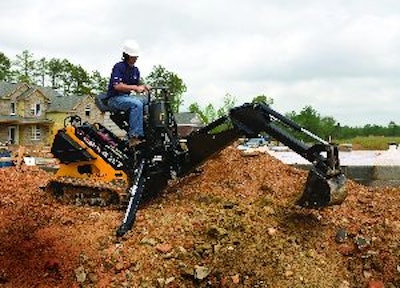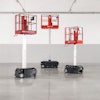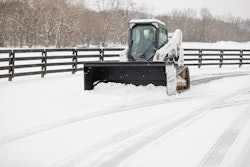
If you walk into a dealership to purchase a particular brand of compact utility loader (also referred to as a mini track or skid-steer loader) and its matching brand attachment, all of the challenges associated with getting the right fit are already resolved by the manufacturer.
For example, Toro engineers and designers have done the work upfront to precisely match the company's 35+ attachments to its line of wheeled and tracked Dingo compact utility loaders. This enables you to realize the best performance from each. "All the attachments we offer are thoroughly tested on our different machines," says Greg Lawrence, Dingo product manager, Toro. "They go through a rigorous testing process to ensure you're mating the attachment to the machine properly."
Each attachments is designed with the carrier in mind. "We spend a lot of time making sure we're maximizing the potential of the attachment, and to ensure it fits the machine properly from a hydraulic and design standpoint," Lawrence states.
The same type of match-making philosophy is honed at Compact Power, where all of its more than 50 attachments have been designed to complement the Boxer line of compact utility loaders.
But what if you want to purchase an attachment from an aftermarket supplier? With the popularity of quick-attach plates, you have the ability to quickly and easily mix and match attachments and machines. But you will want to keep a few things in mind to ensure you get the performance you expect.
Be aware of weight
One of the biggest advantages of a compact utility loader is its ability to maneuver in tight spaces. These units often replace physically demanding work that could only be completed by hand with a wheelbarrow and shovel. As such, you don't want to compromise the machine's ability to accomplish such tasks by weighing it down unnecessarily, or by adding a cumbersome attachment that sacrifices maneuverability, stability and visibility.
Weight is a very important issue with this size of machine, asserts Lyle Helvie, president/owner, Terra Power Attachments. "It's more of an issue with this compact size vs. a traditional skid steer," he says. "That's because contractors want to do similar or the same types of jobs that a standard skid steer can do. While you can do the same job, you have to consider that you can't do it as quickly because you have a smaller machine."
And you certainly don't want to try to use attachments designed for full-size skid steers in an attempt to speed that process. While compact utility loaders continue to gain in horsepower offerings - with some now topping the 30-hp threshold - they still aren't designed to carry their larger cousins' attachments. "Look for attachments designed specifically for minis," says Helvie. "The list of options continues to grow."
Refer to the manufacturer's rated load and tipping capacities to ensure you don't overload the host machine. "If your attachment weighs too much, you can defeat the purpose of a compact utility loader. It can disrupt your jobsite because you're struggling to pick up the attachment," says Lawrence. "Also, if the attachments you use to pick up materials are too large or too heavy, you will limit your ability to lift with the machine because the attachment itself is taking too much of its lift capacity."
Overloading the carrier is not only counterproductive, it can cause damage to the machine. In particular, if the loader runs on tracks, trying to carry too much weight can damage the internal track components, notes Bill Meutze, technical manager, Compact Power.
Impact on stability
Overloading the loader can also compromise stability. "While most machines won't break due to overloading, you do need to be concerned about tipping," says Meutze. "Consider the weight of the attachment, as well as how much any material being carried in a bucket would weigh."
If the attachment is being raised up to the maximum lift height, the weight of the attachment becomes more influential on the machine, Helvie adds. "The center of gravity changes," he explains. "It starts to move farther out in front of the machine, toward the tires that it's balancing on. If you're using a large-capacity bucket with heavy material in it, you need to be careful that you're not reaching the tipping capacity of the machine."
If you find that you're trying to do too much with a compact utility loader, you may need to upsize to a full-size skid steer. "If you need something with attachments that are as big as a full-size loader, compacts aren't what you need," says Meutze. "These are powerful units that are designed for smaller spaces. The two machines are designed for two very different markets."
Hydraulic flow and pressure
An attachment will never deliver more power than the loader supplies to it. That sounds pretty basic. Yet, ensuring you have adequate hydraulic flow and pressure is sometimes overlooked. Oversizing a system by putting too much flow and pressure to the motor can overtax it. "You could have problems that would damage the components," says Helvie. "You may have to repair them more frequently."
But erring too far in the other direction and undersizing a system doesn't take full advantage of the machine's capability. With some larger compacts approaching flow rates rivaling the smallest, full-size skid steers, you don't want to lose out on any potential benefits.
"Engine horsepower and hydraulic capability are some of the biggest factors that affect the performance of an attachment, especially with rotary attachments such as stump grinders," says Helvie. "These mini skid steers aren't just loaders anymore. They don't just move dirt or material from one place to another. They've evolved into mini tool carriers that utilize the engine horsepower in the form of hydraulic output or hydraulic power to drive attachments. So it's important to have the correct flow and pressure available."
Undersizing the hydraulic system typically results in poor performance. The machine may stall out or not complete a task as expected or desired. In extreme situations, the machine/attachment combination simply won't function at all.
Mismatches show up most noticeably in attachments that are flow sensitive, such as stump grinders, snow blowers, concrete breakers, etc., notes Meutze. "If you put a stump grinder that requires 18 to 20 gpm on a machine that only offers 15 gpm, it just wouldn't perform," he says. "It will bog down because the attachment isn't spinning at the proper rpm to achieve the cut."
"You end up with less productivity," adds Helvie.
Before you purchase any attachment, understand the type of work you want to do, even though that type of work can admittedly change once the machine is on site. "When a contractor buys a machine, he may have a particular job in mind," notes Lawrence. "But once he starts using it, he oftentimes finds other tasks that it can do. It evolves. It's really up to the contractor and his creativity as to what the machine and attachments can do."
"That's the beauty of these machines," Meutze agrees. "They are so versatile. As long as you have the right attachment and use it safely, you can get about any job done."
Don't compromise visibility
Because you're not sitting inside a cab, a compact utility loader offers great visibility compared to a traditional skid steer.
"You can easily turn around and see the entire jobsite, whereas with a skid-steer loader, you're limited by the enclosure," Lawrence indicates. "At Toro, we've tried to maximize that visibility. If you buy an aftermarket attachment, you don't want to give up that great visibility that you've gained. Choose an attachment that ensures you're not hindering visibility and putting yourself into a dangerous situation."
Those situations can be more prevalent with a compact utility loader due to the machine's smaller size and ability to work in tighter locations. "You can be working in close quarters. If you can't see your jobsite well enough, you run the potential of running into something," Lawrence points out.
Certain attachments - in particular, those requiring an operator to work in reverse mode - can present greater risk. "With an attachment such as a trencher, you're going backward," Lawrence comments. "Also, anytime you have something that's engaging the ground, you want to make sure you can see what you're doing. Make sure you can see how it's functioning to ensure you're not damaging anything or using the machine improperly."
Before making any attachment purchase, Lawrence advises demoing it first. "Remember that you're investing in your business," he says. "Try to run the attachment before making a purchasing decision to ensure it functions the way you believe it should, and that it works in the conditions you're working in."



















